Features of the TCMCR
Unique Features of the TCMCR
The TCMCR is packed with features to help you in your clinical practice. This section introduces some of them.
Effective Treatment Strategy Reports
Who doesn’t wonder if we are offering the best treatment options to our patients?
Who doesn’t wonder if we are offering the best treatment options to our patients?
Are other practitioners doing things that are more effective than us? Are the textbook mandated approaches the best we can do?
The idea that we can together find out what really works in real world clinical settings is the reason why the TCMCR was originally conceived of and is now a reality.
The generation of these reports, once a critical mass of practitioner uptake has occurred and sufficient data has accumulated, is therefore the defining feature of the TCMCR.
Being part of the TCMCR family gives you access to this unique and exciting program function that empowers you to make informed decisions about treatment selection. By utilising patient-permitted de-identified treatment data, we will be able to eventually identify what truly works in the real world of patient care.
In time, you will have the ability to generate comprehensive treatment strategy reports tailored to your patient’s specific key symptoms and TCM constitutional factors. These reports will offer valuable insights, and enquiries will be able to be generated that either include or exclude TCM diagnostic considerations.
See below for the early design of the form used to generate these reports
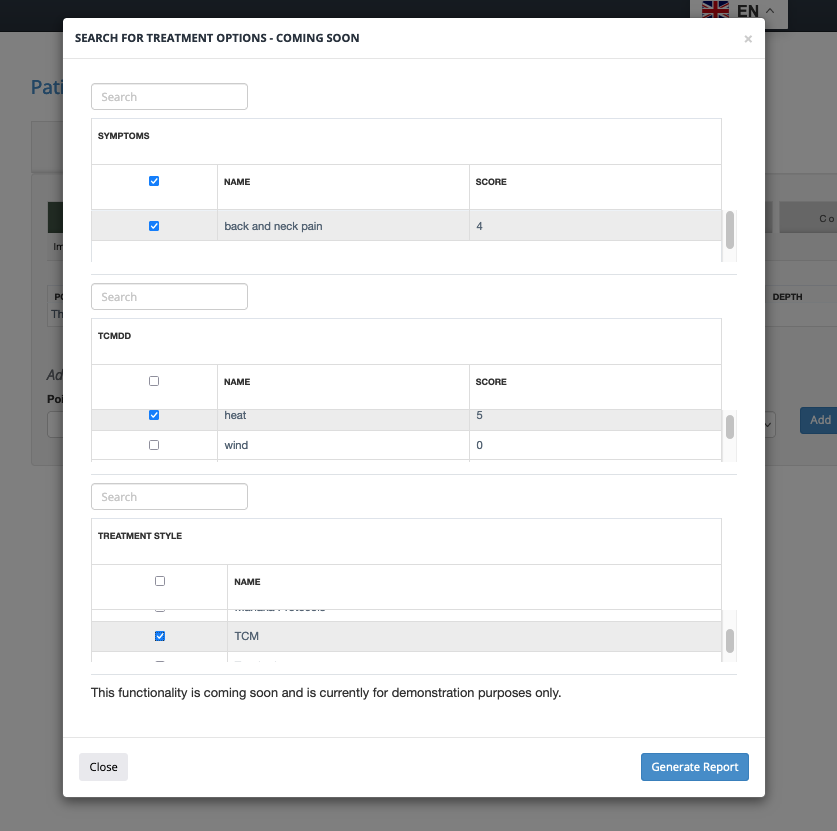
As the form shows, you will have the ability to select or unselect key symptoms and diagnostic factors and screen for treatment styles.
The report generated will look something like this:
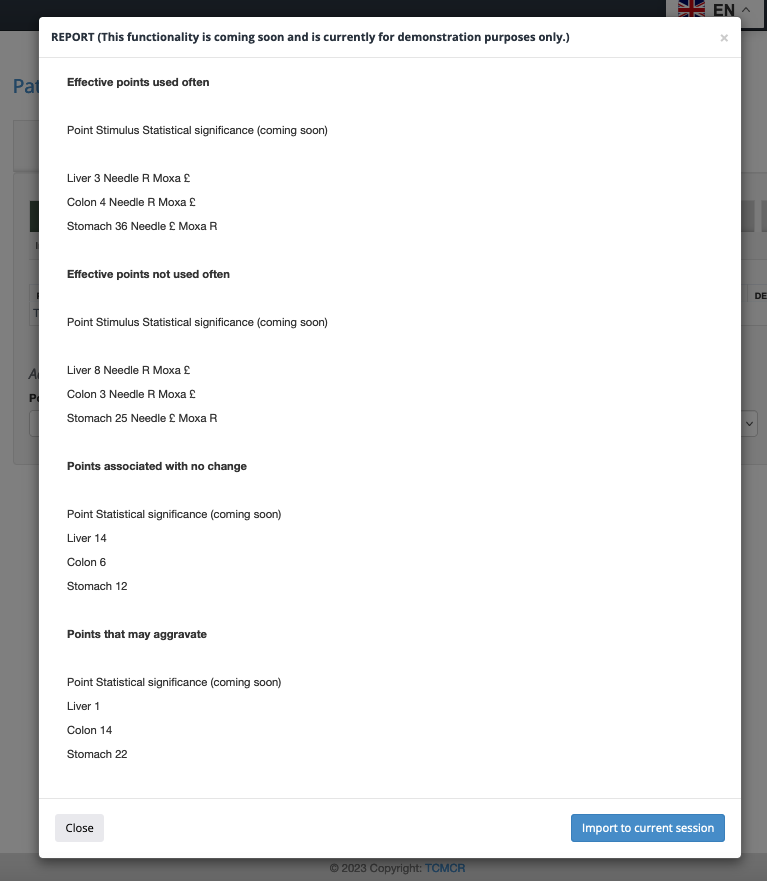
These reports will provide three types of essential information and once this section is operational, the import button will allow easy transfer recommendations to the current session.
- Popular and Effective Approaches: Discover the treatment methods that are widely recognised and proven to be effective in addressing similar symptoms and conditions. Benefit from the collective wisdom and experiences of practitioners worldwide.
- Hidden Gems: Uncover lesser-known treatment strategies that have demonstrated effectiveness, even if they may not be as widely utilised. Expand your repertoire of treatment options and explore innovative approaches that can make a meaningful impact on patient outcomes.
- Learn from Experience: Gain insights into treatments that have been found to be ineffective or, in some cases, worsen a patient’s condition. By learning from these experiences, you can avoid potential pitfalls and refine your approach for better patient care.
By leveraging the power of treatment strategy reports, you can enhance your practice, optimise patient care, and help the progress of and stay at the forefront of evidence-based treatments in Traditional Chinese Medicine.
The TCM Community United
Experience the power of unity within the TCM community through the TCMCR. Our platform brings together dedicated TCM practitioners who, while operating independently, share a common goal of delivering the highest quality medical treatments. Within the registry, practitioners will anonymously exchange insights, and contribute to collective knowledge, nurturing a sense of unity and shared expertise. Together, we will elevate the practice of TCM and provide exceptional care to our patients.
Collection of De-Identified Patient Treatment Data
As introduced in the Effective Treatment Report section above, the TCMCR is designed to enable the collection of patient-permitted de-identified treatment data to support our profession.
When patients are on-boarded to the TCMCR, they are presented with an option to choose whether they wish to share their data. This ensures transparency and respect for patient privacy.
Upon selecting their preference, patients receive an email confirming their decision. It’s important to note that patients have the flexibility to change their mind regarding sharing their de-identified data at any time, empowering them with control over their information and promoting a patient-centric approach.
By gathering this de-identified treatment data, the TCMCR facilitates valuable insights and analysis that can contribute to advancements in the field of Traditional Chinese Medicine. This data-driven approach enables practitioners and researchers to identify patterns, uncover effective treatment strategies, and enhance patient care outcomes. The TCMCR platform upholds the highest standards of data security and privacy, ensuring confidentiality while harnessing the collective knowledge of the TCM community to drive progress and innovation.
For Oriental Medicine Practitioners only
The TCMCR is exclusively tailored for qualified TCM (Oriental Medicine) practitioners, ensuring the highest standards of care. In the near future, additional measures will be implemented to verify the appropriate qualifications of registered users, guaranteeing the integrity of the program. We are committed to upholding the professional standards of TCM and ensuring that only qualified practitioners have access to the TCMCR platform.
Rest assured, the TCMCR will not support practitioners who have completed only short courses or primarily practise another modality with minimal acupuncture qualifications. Furthermore, the program does not endorse or facilitate “dry needling” practices. We are dedicated to maintaining the authenticity and credibility of Traditional Chinese Medicine, ensuring that the TCMCR community consists of experienced and qualified professionals. Join us and be part of a community that upholds the highest standards of TCM practice.
Superior Patient Records Management
Even without the Effective Treatment Strategy Reports, we believe the TCMCR is the best software yet developed to effectively record and manage TCM patient records.
Let’s now introduce some of the TCMCR’s program features.
Calendar Management
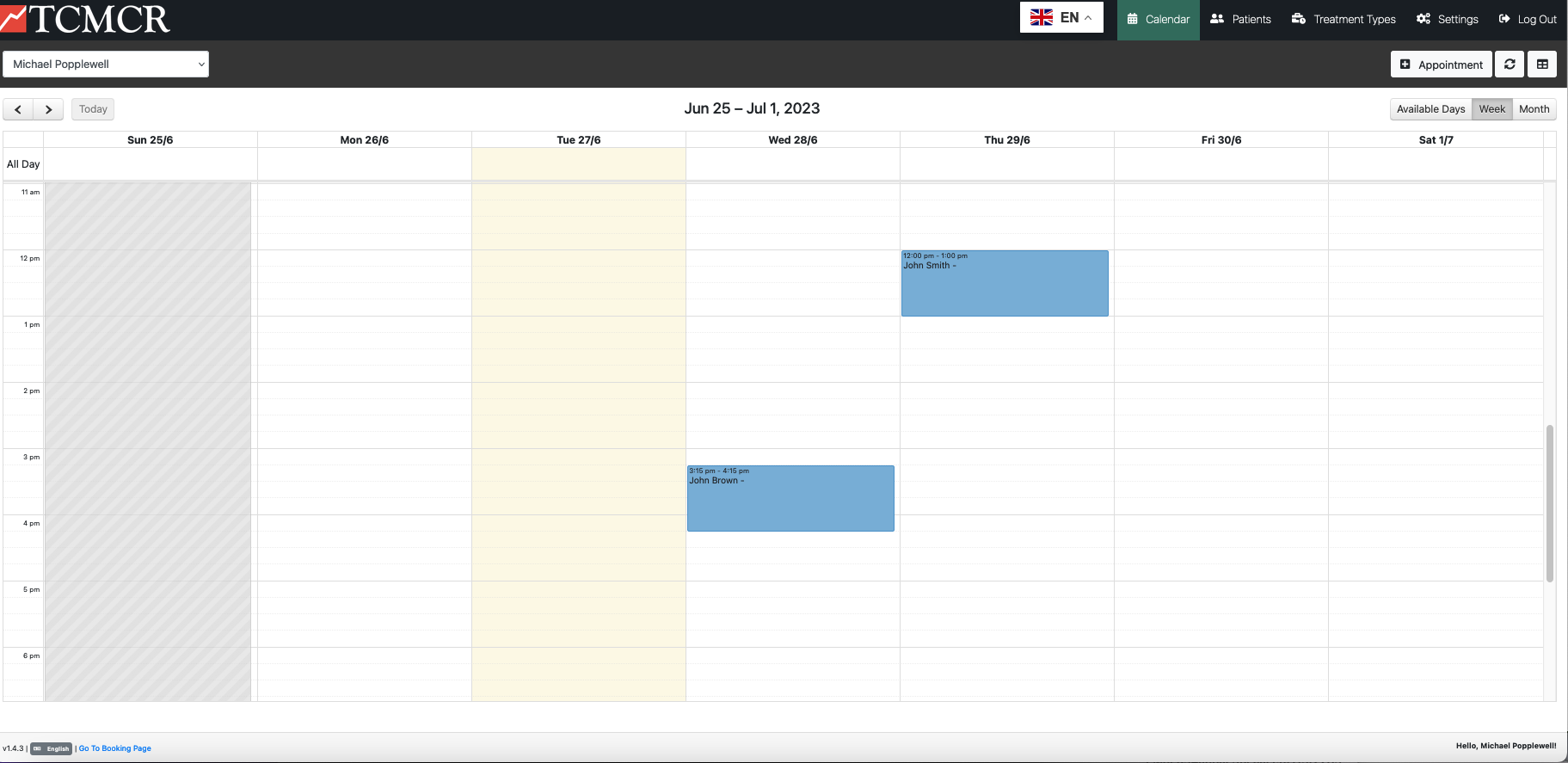
With the TCMCR, you have the advantage of an integrated calendar that streamlines your patient management and provides seamless access to patient records. After logging in, the program can be configured to open directly to either the calendar or the patient records module, based on your preference.
The calendar in the TCMCR offers a comprehensive set of features to effortlessly manage your patient workflow. You can:
- create custom treatment descriptions, specifying the type of treatment, its cost and duration.
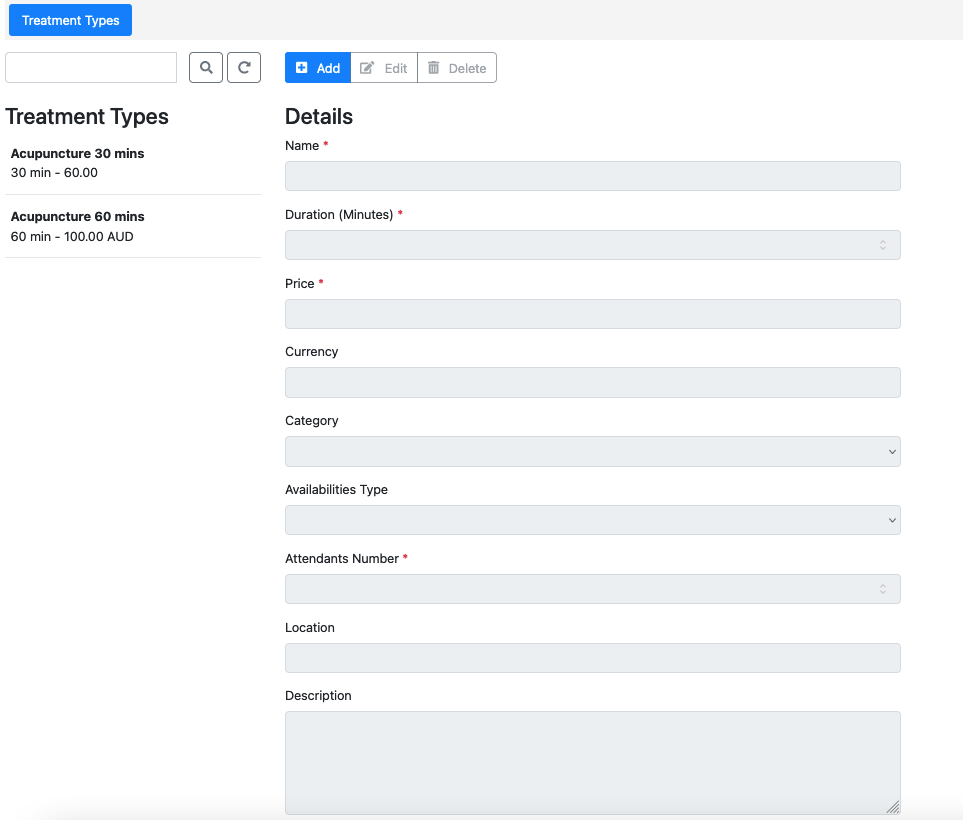
- Set your online availability by blocking out days when you’re not available and defining your starting and finishing times.
- View and use your calendar in daily, weekly, or monthly formats with ease.
- Change appointments easily through a number of approaches, including an intuitive drag-and-drop function.
- You can also mark specific time slots as unavailable for breaks or other purposes.
The calendar serves as a convenient gateway to access your patients’ treatment records. This seamless integration ensures that you can efficiently retrieve, review or add relevant information from your appointments interface.
The TCMCR empowers you with an all-in-one solution that optimises your practice management and enhances the patient experience.
Language Support
Easily convert the TCMCR to different languages with a simple button click. Access the language section located in the bottom right of the website.
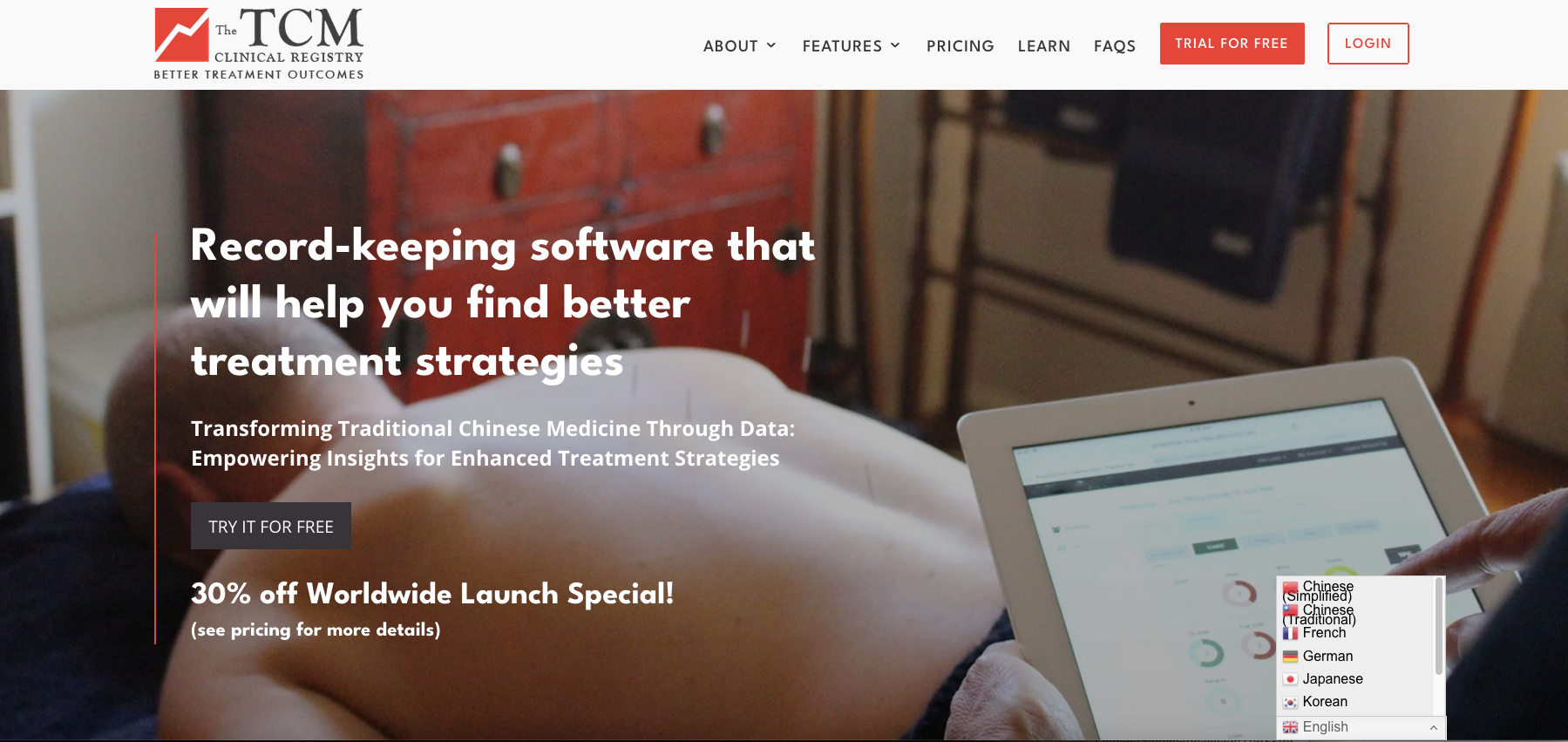

And in the same place in the treatment recording module

Currently, we support the following languages as well as English:
- Traditional Chinese
- Simplified Chinese
- French
- Spanish
- German
- Portuguese
- Japanese
- Korean
If we haven’t yet included your preferred language, please let us know and we will endeavour to correct this for you.
The Clinical Notes Module
Efficient, Compliant Treatment Recording
The treatment recording module of the TCMCR sets a new standard for efficient and compliant treatment recording. With its specialised design, it excels in accurately documenting Oriental Medical treatments in a streamlined manner. Whether you’re practising in Australia, the US or any other jurisdiction, the TCMCR is designed to meet the clinical record keeping requirements worldwide.
Our Clinical Notes Module offers a user-friendly interface that enables practitioners to record treatment details efficiently and effectively. From capturing diagnostic information to documenting treatment plans and processes, the module provides a comprehensive solution for maintaining thorough and accurate clinical records.
We are committed to ensuring that our platform encompasses all the necessary elements to fulfil your local requirements.
Please let us know if there are any specific needs or features you would like us to incorporate for your local requirements.
Paper Onboarding Form
The first meeting with patients is a crucial time, one where your full attention needs to be focussed on the needs and health issues your patients are facing.
Splitting your attention between your patient and a computer screen can be a negative experience for your patient in this first session.
Therefore, to provide support during this initial interview, a printable paper form is provided here (Paper Form Content)
Preloaded Intervention Lists
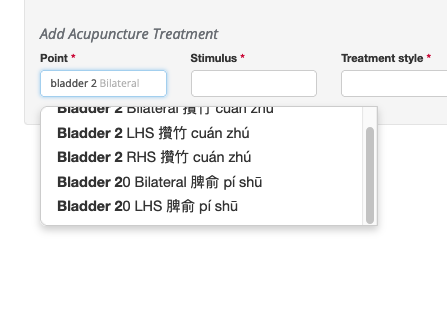
With the TCMCR, you can enjoy the convenience of pre-loaded lists containing all acupuncture points in English and pinyin, and soon, a comprehensive Chinese herb list, facilitating efficient and seamless treatment recording.
Intuitively Follows the Interview
The TCMCR follows the patient interview and seamlessly guides you through their symptom review and treatment recording process.
- It begins by capturing your patient’s key symptoms, which are then tracked throughout their treatment course.
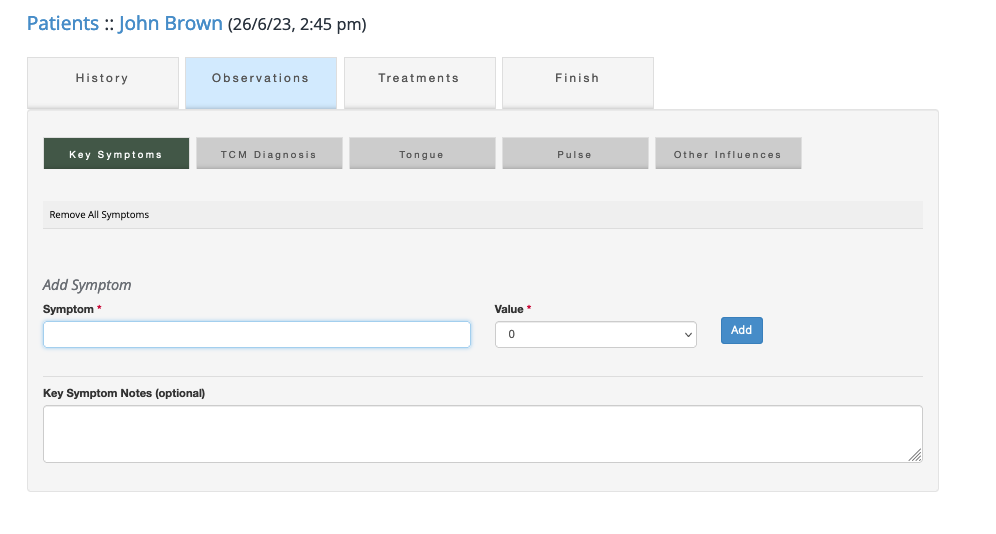
- Next, their TCM diagnosis is documented using the TCMDD, an innovative diagnostic format that enhances inter-practitioner agreement (see more in the Nerdy Stuff section), followed by their tongue and pulse characteristics. Other Factors such as Western medication, variations in family or work stress etc are also recorded here.
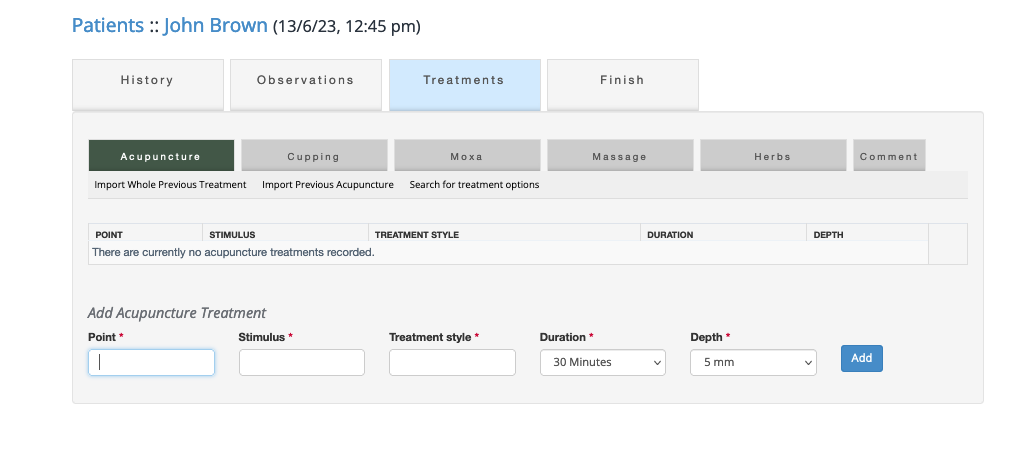
- Finally, you can comprehensively record all aspects of the treatment before saving the complete record.
Editing Previously Recorded Treatments
We have all shared the experience of inadvertently overlooked recording certain aspects of a patient’s treatment due to various reasons. To address this, the TCMCR offers two options for editing previously recorded treatments.
Firstly, practitioners have a 24-hour window where they can make edits without generating any notation on the clinical record. This allows for quick adjustments and additions to be made seamlessly.
Secondly, even after the initial 24-hour period has passed, practitioners still have the flexibility to edit the previous three treatments. However, it is important to note that similar to how you would handle editing a paper record, a notation is made on the record indicating that changes were made to maintain transparency and accuracy.
Efficiencies for Recording Ongoing Patient Treatments
The TCMCR is designed to support practitioners in efficiently making clinical notes for their patients, and it offers several features to streamline this process. One such feature is the ability to import previous treatments, key symptoms and TCMDD diagnoses, providing a convenient starting point for recording ongoing treatments. This feature is specifically designed to enhance the efficiency of note-taking, saving practitioners valuable time.
Once the initial onboarding session is completed, recording subsequent treatments becomes a seamless task. By importing previous treatment data and relevant patient information, practitioners can quickly access and edit the necessary details, allowing for more efficient and accurate clinical note-taking. This feature ensures that practitioners can focus on providing quality care to their patients while minimising administrative burdens.
Reverting to a Previous Treatment Strategy
The TCMCR offers the convenient feature of importing previous treatments, allowing practitioners to easily revert to a previous treatment strategy when needed. This functionality is particularly valuable in situations where there has been an interruption in the long term treatment of a chronic condition due to an acute phase.
For instance, let’s consider a scenario where you were successfully treating a patient for chronic insomnia, but had not yet completed a course of treatments. Suddenly, your patient develops the flu, requiring immediate attention.. Once the flu has resolved, you can seamlessly return to your previous treatment approach by accessing and selecting the appropriate previous treatment from the treatment history.
By clicking on earlier dates in the treatment history, you can view and choose the most suitable previous treatment as a starting point for recording and resuming the previous approach. This functionality provides practitioners with the flexibility and convenience to maintain continuity and patient care, ensuring that treatment strategies can be easily revisited and implemented as needed.
Here is an example of a previous treatment viewed before importing.
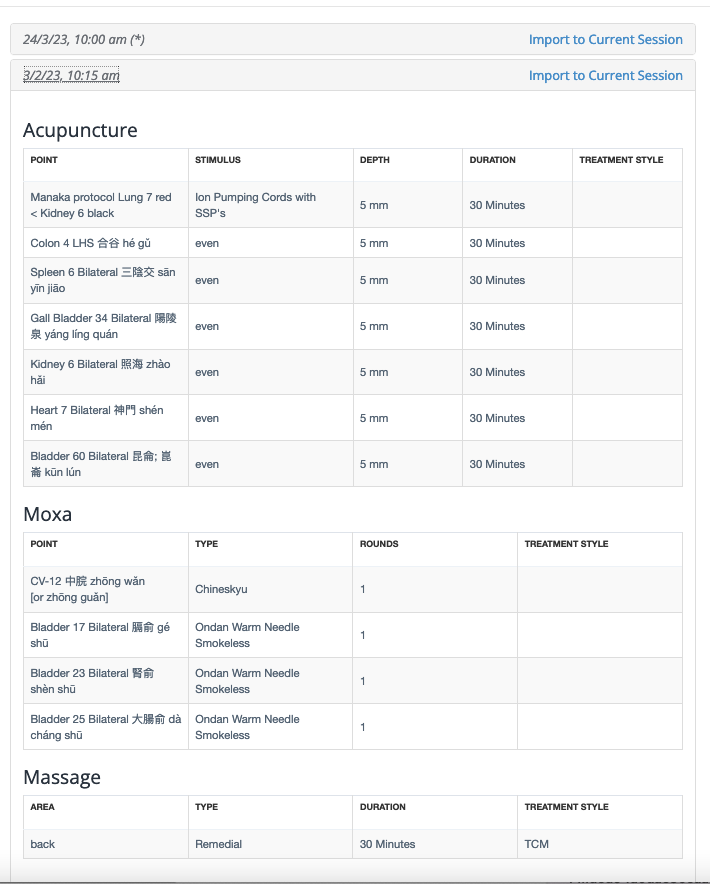
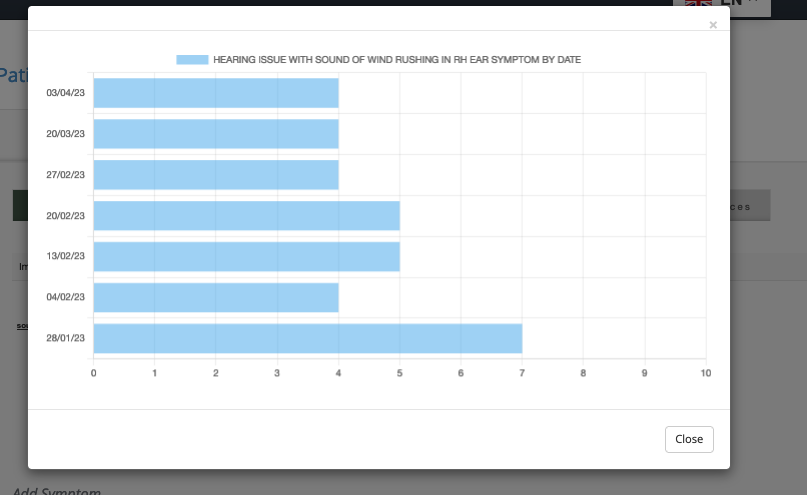
Visualising Patient Progress
By clicking on the history link of a key symptom, you can unlock a powerful visual representation of the patient’s progress. The Symptom Wheel allows you to access the patient’s progress in each attribute, providing valuable insights into their journey. The graph displays the most recent score on top, while the earliest score is positioned at the bottom. On the left side of the graph, you’ll find the dates of treatment, offering a comprehensive view of their progress over time.
This feature serves as a valuable tool for both you, the treating practitioner, and your patients. It allows you to review and analyse each attribute throughout the therapy sessions. Furthermore, you can share these representations with your patients, enabling them to witness their improvements firsthand.
Below you’ll find an example of a history graph showcasing a Key Symptom.
Simplified Onboarding: Joining Us Made Easy!
We understand the importance of a seamless joining process, and we are here to support you every step of the way. Our aim is to make the transition as effortless as possible for you. Even if you are currently using another software application, you can still enjoy the full benefits of the TCMCR without any disruption.
Free Migration Assitance
When you decide to switch to the TCMCR from your existing program, we provide complimentary migration assistance.
Contact us to start the process.
Free Demonstrations
Experience the power of the TCMCR with our free online demonstrations – book a demo today to get all your questions about the TCMCR program answered and discover how to maximise its benefits for your practice.
By attending a demo, you not only gain valuable insights into the TCMCR program, but you also qualify for a substantial discount when you register at the end of the session, making it a win-win opportunity for your practice
Use of the TCMCR with other programs
Treatment Note Copy and Paste
Whether you are currently using another program to manage your appointments or exploring the TCMCR before migrating, our platform allows you to easily copy and paste your TCM treatment notes upon completion recording a session, ensuring seamless integration and convenience.
Extensive Help & Support
Once you register with the TCMCR, you’ll be supported by our comprehensive help section, offering detailed step-by-step guidance on all the program’s functions. We’re committed to providing you with the support you need to make the most of our platform and optimise your TCM practice.
The Nerdy Stuff
Diagnostic Reliability
The TCMCR utilises the Traditional Chinese Medical Diagnostic Descriptor (TCMDD), a validated diagnostic format developed by Dr Michael Popplewell,the founder of the TCMCR. Dr Popplewell’s extensive research during his PhD focused on enhancing diagnostic reliability within the TCM profession, resulting in the creation of TCMDD.
With TCMDD, a set of fifteen descriptors is employed, allowing practitioners to score each descriptor on a scale of 0-10, effectively capturing the essence of a patient’s TCM diagnosis. This standardised approach offers a robust framework for accurate and consistent diagnostic assessment, empowering TCM practitioners to provide more precise and effective treatments.
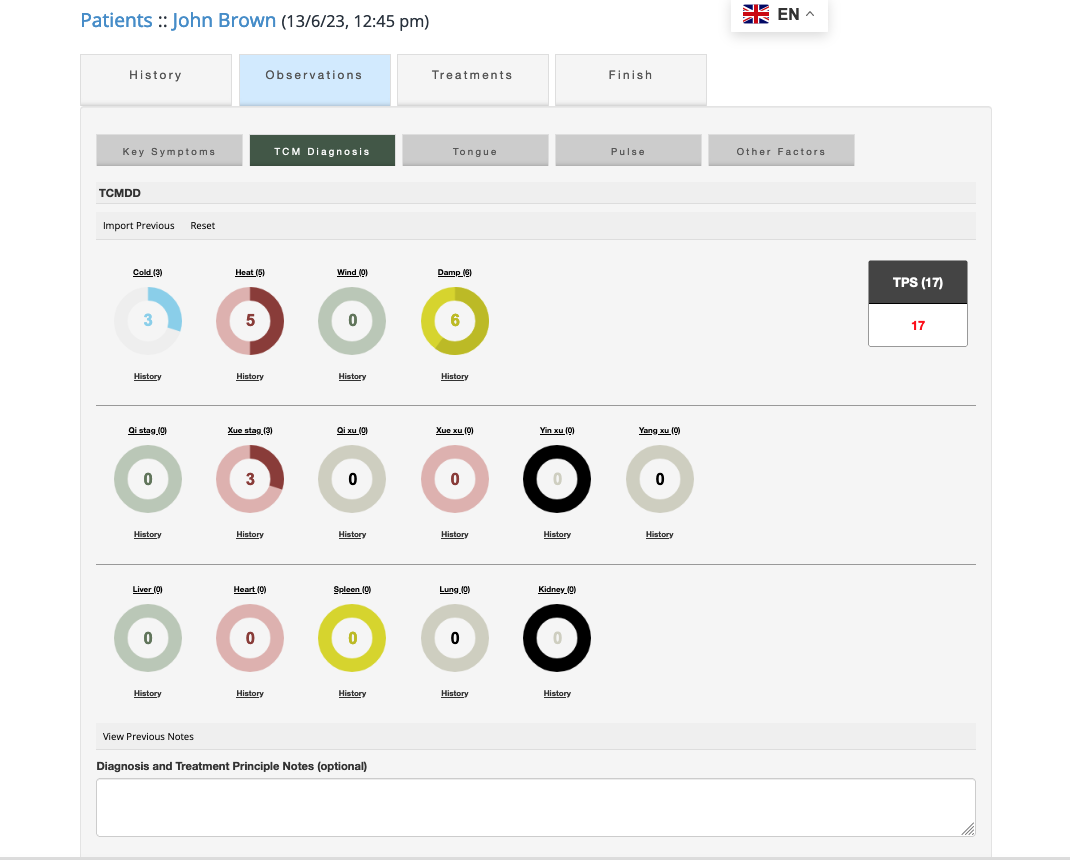
Total Pathogenic Score
The Total Pathogenic Score (TPS) is a comprehensive metric that quantifies the overall health of the patient by summing up all the Descriptor Scores. It provides a direct assessment of the patient’s condition. The correlations between TPS and the widely recognised wellness measure, the SF36, were documented in Dr. Popplewell’s PhD research, and further investigation of this relationship is planned for the future.
The implementation of TCMDD within the TCMCR has demonstrated a significant improvement in diagnostic consensus compared to the contemporary TCM diagnostic format, with consensus rates increasing from 19% to 80%
These findings are supported by a series of three peer-reviewed papers published in 2019, validating the effectiveness of the TCMDD. Additionally, a renowned Oriental medical academic, Stephen Birch, provided a supportive commentary on these papers.
The inclusion of TCMDD in the TCMCR represents a novel and powerful feature, aiming to enhance the search for effective treatments for your patients by incorporating TCM constitutional considerations. By utilising this advanced diagnostic approach, we can collectively validate and refine the constitutional approaches of TCM, revolutionising the field and ultimately improving patient outcomes.
Planned TCMDD Enhancements
Symptom Lists
Concise lists of essential symptoms for each descriptor will be created and incorporated into the TCMDD within the TCMCR. This addition aims to assist practitioners in their diagnostic process by providing them with valuable support.
ICD11 Coding
The comprehensive range of medical conditions outlined in the International Classification of Diseases, 11th edition (ICD-11), will be systematically coded using the TCMDD. This coding process will establish a connection between the intricacies of the ICD and the streamlined organisation offered by the TCMDD, enabling a more rational approach to healthcare management.
Completed Treatment Units
The collection of Completed Treatment Units (CTUs) from consenting patients, with their de-identified data, forms the foundation of this project, providing valuable insights.
As CTUs continue to accumulate, they will increasingly empower us to better understand the effectiveness of various treatments and Chinese medical constitutional diagnoses in real-world conditions.
Pragmatic data plays a pivotal role in unravelling the dynamics of clinical practice, enabling us to identify what truly works.
Through harnessing the transformative insights derived from extensive pragmatic data, the TCMCR strives to foster continuous improvement within our profession, with your invaluable contribution as a member of the TCMCR community.
CTUs help address key clinical enquiries, such as:
- Predicting the optimal number of treatment sessions for favourable outcomes in specific conditions with different TCM diagnoses.
- Evaluating the comparative effectiveness of various treatment styles, both overall and in specific conditions.
- Assessing the influence of TCM constitutional factors on effective interventions for the conditions we treat.
- Investigating the potential existence of universally effective point combinations across cases.

Symptom Wheels
Symptom Wheels are a powerful feature in the TCMCR for capturing diagnostic data with efficiency and accuracy.
You’ll find Symptom Wheels integrated across the program, including sections like:
- Feedback from Previous Session
- Key Symptoms
- Diagnosis
- Tongue
- Pulse
- Other Factors.
Take a look at the screenshot below to see how a Symptom Wheel was utilised to record a Key Symptom.
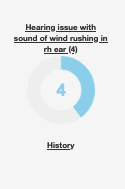
The Symptom Wheels in the TCMCR program have several common features, and you can find detailed information about them in the program’s help section. One notable feature is the use of Likert scales to assess symptom severity or other relevant factors.
Likert Scales
The Symptom Wheels in the TCMCR utilise Likert Scales ranging from 0 to 10 to accurately capture and assess the severity of symptoms.
Research, such as the study conducted by Boateng et al. in 2018, has shown that using numerical ratings, like those in Likert Scales, is more effective than using descriptive words in accurately describing symptom severity and detecting changes in symptom expression.
Future Plans
Automated Patient Follow-ups
Use of PROMS
Eventually we are aiming to implement targeted patient follow-ups to validate treatment outcomes using confidential Patient Reported Outcome Measures (PROMS) originated from TCMCR. These audits will serve the purpose of confirming and validating treatment outcomes, while also providing valuable feedback to practitioners regarding their estimation of patient Key Symptom improvements throughout or at the end of a treatment course.
Furthermore, the utilisation of PROMS will ensure the reliability and strength of the clinical data collected by the TCMCR.
Follow Ups After a Final Session
We are also in the process of developing processes to allow practitioner-initiated and automated patient follow-ups. These follow-ups will take place either when a patient has chosen not to return without a specific reason or as a follow-up to their final session. Both are designed to fulfil the aim of maximising the accumulation of CTUs (Clinical Treatment Units).
By implementing these follow-ups, we not only increase the potential for accumulating more CTUs but also create additional opportunities for practitioners. This is because patients may disclose unresolved issues that still require attention, thereby providing practitioners with more work and the chance to address any ongoing concerns.
